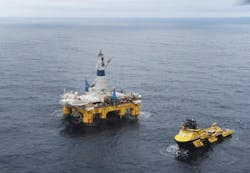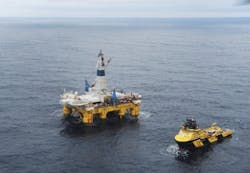F. Jay Schempf
Contributing Editor
Arctic and sub-Arctic offshore drilling and production activity is expected to gain new vitality in upcoming years, as more than 130 Bboe have been identified as either discovered or slated for development through 2017, according to Infield Systems Ltd.
The London-based research firm includes current and near-future developments inside the Arctic Circle as well as those found in “sub-Arctic” regions just below it. The sub-Arctic fields identified include Sakhalin Island in the Sea of Okhotsk off Russia’s eastern coast and the Jeanne D’Arc Basin off Eastern Canada, among others.
About 114 Bboe, or 80% of the total, are gas reserves, with the remaining 16 Bbbl of oil, located in 147 discovered fields, of which only 25 are currently producing. Another 13 fields are either under development or have a firm plan for near-future action. The remaining 101 fields are classified as “possible.”
Arctic capital spending should increase steadily throughout this current decade, says Infield, rising at more than $7 billion a year through 2017. Russia, with its large reserves, likely will drive the expenditure growth, particularly during 2013-1015. The following is a roundup of recent offshore developments in both Arctic and sub-Arctic areas.
Norway
Despite a spate of dry holes drilled during 2008 and cessation of drilling of any kind for several years thereafter while its Barents Sea border with Russia was being resolved, Norway’s sector has finally yielded a breakthrough discovery. Statoil, with partners Eni and Petoro, announced a significant oil and gas discovery in March on the Skrugard prospect about 100 km (62 miles) north of the Snøhvit field.
Transocean’s fourth-generation semisubmersible rigPolar Pioneer drilled the recent Skrugard discovery in Norway’s sector of the Barents Sea. Skrugard is believed to contain recoverable reserves of 150 to 250 MMboe. Photo courtesy Statoil.
Drilled in about 373 m (1,224 ft) of water, the well has an oil column of 90 m (295 ft) and a gas column of 33 m (108 ft). Estimated recoverable reserves are between 150-250 MMboe, with further upside development of an additional 250 million boe within the Skrugard license area.
Statoil plans to drill a new prospect in the same license area sometime later this year, as well as possible further development drilling at Skrugard.
The Snøhvit gas development, where three major gas finds have been made since 1984 and whose current reserve estimate tops 193 bcm (6.8 tcf) of natural gas, 113 MMbbl of condensate and 5.1 MM metric tons (5.6 MM tons) of natural gas liquids, remains the only field center established so far in Norway’s Barents Sea sector. The fields are located about 140 km (87 mi) northwest of Hammerfest. Several delineation wells are planned for Snohvit this year.
Russia
Part of the Phase I development plan for the massive Shtokman offshore gas and condensate field in Russia’s Barents Sea sector was to assemble two fifth-generation Moss Maritime CS-50 harsh environment semisubmersible drilling units at a Murmansk shipyard during 2010 and early 2011 for eventual development drilling in the field.
Last year, however, when Shtokman license-holder Gazflot postponed estimated first production from 2013 to 2016, it decided to move the rigs’ hulls via barge to a point near Samsung Heavy Industries’shipyard in South Korea, where the topsides were built, and to employ the completed rigs subsequently in development of Sakhalin III . These voyages, made last year, covered a distance of more than 27,000 km (16,777 mi).
The rigs,Polar Star and Northern Lights, are designed to drill to 7,500 m (24,600 ft) in water depths to 500 m (1,640 ft) in ambient temperatures ranging down to -30°C (-22°F).
Shtokman, discovered in 1988, is located about 555 km (345 mi) northeast of Murmansk in water depths to 350 m (1,148 ft). Estimated reserves are some 3.8 tcm (134 tcf) of gas and about 37 MM metric tons (40.8 MM tons) of gas condensate. Phase 1 plans include drilling some 156 wells comprising 144 producers, three monitors and nine reserve wells. About 40 of the producers will be completed subsea, with the rest drilled by the two semisubmersibles and from tethered floating drilling/production structures (most likely TLP or spar-type platforms). The operator is the Shtokman Development Co., a Swiss-registered joint venture of Gazprom (51%), Total (25%) and Statoil (24%).
Russia’s second Barents Sea field, Prirazlomnoye, is due to be outfitted with its offshore ice-resistant fixed platform (OIRFP), recently completed at a Russian shipyard and towed to Murmansk for outfitting and precommissioning prior to installation in the field this summer.
The field, discovered in 1989, is located on the Pechora Sea shelf in water depths to 20 m (66 ft) about 60 km (37 mi) from shore.
Primarily an oil field, Prirazlomnoye holds reserves of some 610 MMbbl. Gazprom expects to drill up to 40 directional wells (19 producers, 16 injectors and five reserves), all by the land drilling rig installed on the platform.
In the Sea of Okhotsk off eastern Russia, development drilling activity continues around Sakhalin Island, both offshore and via horizontal wells drilled from the beaches of the island itself. Two phases of Sakhalin development already are well under way at Sakhalin I and II.
In a recent development, Gazprom announced it will drill two offshore gas production wells this year at the Kirinskoye field, which stretches seaward from Sakhalin Island to about 28 km (17.4 mi) offshore. Discovered in 1992, the field’s water depth averages 90 m (295 ft).
The field currently holds estimated reserves of 100 bcm (3.5 tcf) of gas and 114 MM m tons (12.6 MM tons) of condensate. It is scheduled to go on stream in 2014. It will be the first project in the Sakhalin offshore area carried out solely by Russian companies.
Kirinskoye is Gazprom’s top development priority offshore Sakhalin and is the resource base for the Sakhalin III project, which is slated to become one of the basic sources of gas supply for large areas of eastern Russia. Gas reserves in Sakhalin III are estimated to be about 1.4 tcm (4.9 tcf), the bulk of which lie beneath the Kirinsky block.
Greenland and Atlantic Canada
Greenland waters remain an attractive frontier offshore arena, despite the fact that no confirmed discoveries have been made there so far. Located in the Baffin Bay basin, similar in size to the North Sea, it was the scene last year of a series of exploratory wells drilled by Scotland’s Cairn Energy as operator for itself and joint-venture partners Nunaoil, Greenland’s national oil company, and Petronas, Malaysia’s government company.
Using two semisubmersible rigs, theStena Don and the Stena Forth, Cairn drilled three wells off Greenland in 2009-2010, targeting prospects located in water depths ranging from 300-500 m (984-1,640 ft) located about 175 km (108 miles) off Disko Island, western Greenland. One of the wells, the T8-1, cut thin gas sands, and another well, the Alpha-1S1, was suspended pending possible re-entry. Cairn plans a new, four-well exploration program off Greenland during 2011. The company has contracted for two deepwater DP rigs to drill the wells.
In the Jeanne d’Arc basin, the Hibernia field, discovered in 1979, continues to grow in importance to Canada’s east coast offshore exploitation. Located about 315 km (196 miles) east of St. John’s Newfoundland and Labrador in water up to 80 m (262 ft) deep, Hibernia, along with satellite Avalon, continues to produce light, sweet crude oil for operator Exxon Mobil (33%) and partners Chevron (27%), Suncor (20%), Canada Hibernia Holding Corp. (8.5%), Murphy Oil (6.5%), and Statoil (5%).
In January, the Canada-Newfoundland and Labrador Offshore Petroleum Board boosted their reserves estimate for Hibernia by 12% to 1.395 Bbbl of oil, an increase of 151 MMbbls from the previous estimate in 2006. The new figure includes possible reserve addition from the upcoming Hibernia Southern extension project, which is expected to add an additional 230 MMbbl of oil to Hibernia production.
In addition to all of this, there is the White Rose field. Located in the Jeanne d’Arc basin about 350 km (217 mi) east of Newfoundland, White Rose was discovered in 1984. It holds an estimated 305 MMbbl of recoverable oil, while its three satellite discoveries, North Amethyst, West White Rose, and the South White Rose Extension, will add more.
North Amethyst, for example, holds an estimated 130 MMbbl of oil, and is the first of the three satellites to be developed. It features the first subsea tieback off Canada. White Rose is owned by Husky Energy (72.5%) and Suncor (27.5%).
In recent weeks, Husky officials mentioned it is considering using narrow, fixed-wellhead gravity based platforms as one option for tapping the additional reserves during early stage development. The platforms would be capable of drilling wells, but with no processing or other onboard functions, would merely pump oil into offloading buoys for shuttle tanker export.
Still another gravity based production system – this time a big one – will be used to develop the Hebron heavy oil project, located 350 km (217 mi) off the eastern coast of Newfoundland and Labrador in water depths ranging to 92 m (302 ft).
Discovered in 1981, the field has taken a long time to develop, due mainly to disputes between the Newfoundland/Labrador government and the joint venture companies involved.
Hebron is estimated to contain between 400-700 MMbbls of recoverable 20° API oil. The project itself consists of the Hebron, West Ben Nevis and Ben Nevis fields. Operated by Exxon Mobil (36%), the joint venture partners include Chevron (26.7%), Petro-Canada (22.7%), Statoil (9.7%) and Nalcor Energy (4.9%).
Last November, Kiewit-Aker Contractors received the FEED contract for the Hebron gravity based structure, to be made of reinforced concrete, with installation in 2016. WorleyParsons was awarded the FEED contract for the platform’s topsides module.
The platform is designed to handle production of 119,506-176,115 b/d. It also will be capable of storing up to 1.45 MMbbl of oil in various storage compartments.
The final project off Newfoundland-Labrador is the Mizzen prospect, located in the Flemish Pass basin. Operator Statoil drilled two wells there in 2009, one of which encountered hydrocarbons. Mizzen lies 500 km (311 mi) east-northeast of St. John’s. It is owned by Statoil (65%) and Husky (35%). Located at a water depth of 1,100 m (3,609 ft) in stormy seas, Mizzen will be a difficult development candidate.
Tapping a reservoir beneath the original Cohasset-Panuke oil field – Canada’s first offshore project, now abandoned – Deep Panuke is located on the Scotian shelf about 250 km (155 miles) southeast of Halifax, Nova Scotia.
Owned 100% by Encana, the field holds an estimated 25.1 bcm of gas. Production from subsea wells will be processed aboard a jackup mobile production unit and transported via subsea pipeline to Goldboro, Nova Scotia, for further transport to market via the Maritimes & Northeast Pipeline. First gas is expected from Deep Panuke later this year.
United States
Located in water averaging 3 m (10 ft) in depth, the Nikasitchuq oil field lies just offshore of Alaska’s North Slope in the Beaufort Sea. Discovered in the period 2004-2007 by Kerr McGee, the field was acquired by Eni in late 2007, and field development began in 2008-2009.
The field contains estimated oil reserves of 220 MMbbl. Development drilling has included directional wells drilled from an onshore drilling pad. Further development will be handled from an artificial island to be built about 4.5 km (2.8 mi) offshore.
Miller Petroleum recently began operations to bring the Osprey offshore platform in Cook Inlet back into production, which originally produced oil from the old Redoubt Shoal Unit. Abandoned years ago, Osprey wells once produced at a rate of 4,900 b/d.
Elsewhere in Cook Inlet, the state has cleared Australian company Buccaneer Energy Ltd. to invest $30 million to mobilize a jackup rig to the inlet area. If acquired, the rig would be available to third parties, including Buccaneer itself, which has committed to drill, at least four wells in the inlet during 2011.





